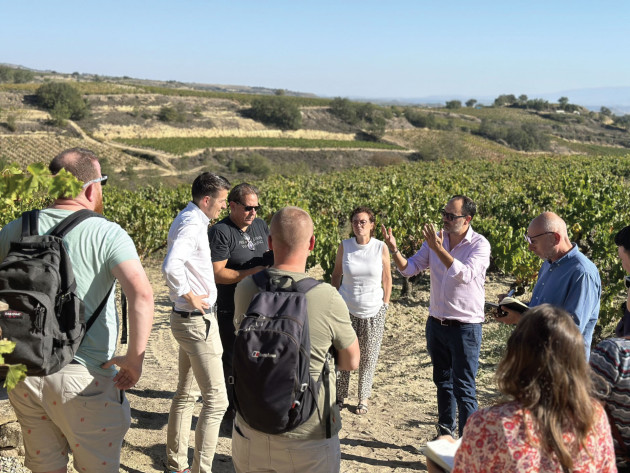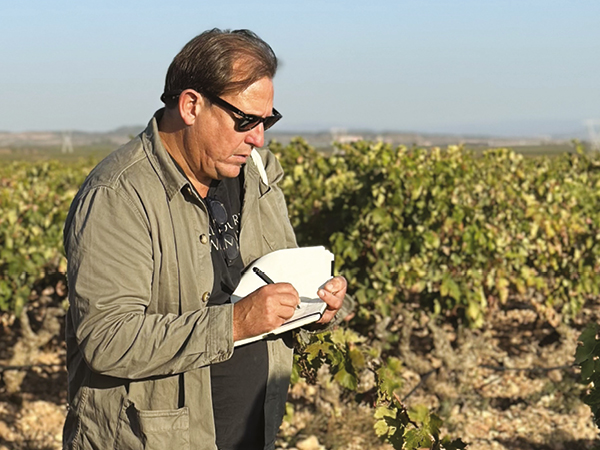
Embracing change in Rioja
Setting out to discover the renewed dynamism and diversity in Spain’s flagship DO, Harpers teamed up with Wines of Rioja to host an indie merchant buying trip to the region. Andrew Catchpole reports.
Rioja has long been the torch bearer for quality Spanish wine, but it can have escaped few observers that the region has been undergoing a renaissance in terms of evolution and change. Legally, the near-100-year-old system of crianza, reserva and gran reserva was eased in 2017, accelerating moves already underfoot. The aim was to bring in much greater flexibility and a clear focus on terroir, with the creation of Vino de Zona (delineating the broader Alta, Alavesa and Oriental sub-regions), the village-focused Vino de Pueblo, and the crowning Viñedo Singular, allowing winemakers to (officially) shine the spotlight on individual vineyards and sites.
The old – and still popular – ageing-based system remains very much in place, but the new designations are driving a revolution in terms of experimentation and delivery of single site and sometimes single variety wines, with a growing emphasis on whites and rosados also to the fore.
All in all, it’s a boon for indie merchants looking to update their Rioja listings, allowing for modern and traditional styles to sit cheek-by-jowl, with the benefit that the former are well placed to attract new and younger drinkers.
And all of this inevitably generated quite a lot of excitement among the indie merchants that joined Harpers this year for the Rioja Buyers Trip, not least as some of this quality-focused group had never been to the region before.
“We have customers looking for crianza, reserve, gran reserva, but on the flip side, as we do a lot by the glass, we have the flexibility to open things and get people to try them,” said Kate Millar of Bin Two. “So we have quite a lot of modern Riojas, different styles from younger generations that are producing different things.
“So we have a bit of both; the older generation looking for more traditional, the younger willing to try new things by the glass.”
Luvians’ Archie McDiarmid concurred, adding: “Rioja has been a safe bet and what is really interesting is that in the past few years that has been starting to change.
“You’re beginning to see more focus on things like Garnacha, Viura, different grape varieties coming through, and being talked about on labels, some of the whites are coming through, and you’re also getting a younger crowd – there’s been a real change there.”
↓
Greater flexibility
The first visit was to Bodegas Fos in Rioja Alavesa. Here, set against the a spectacular view across the village of Elciego toward the Sierra Cantabria, commercial manager Eladio Fernández elaborated on why this producer had embraced such change.
“We wanted to show we could produce single vineyard and local (village) wines – we had this in the past, but could not show Vino de Elciego on the label. Now it’s a lot more flexible.”
Fos was a great introduction to all that’s going on, with single site and village wines, certainly, but also single varietal Tempranillo and Graciano in the portfolio.
However, Fernández also proudly showed an equally captivating 2016 Gran Reserva (100% Tempranillo) to top the tasting, “fresher and more structured” than of old, showing a “restyling” of the category, as he put it.
The mix prompted Heather Smith of Solent Cellar to say that all styles had a place, with the new playing off – and even into the hands of – the more traditional.
Solent finds a ready market for crianzas and reservas as ‘house’ wines for the restaurants and pubs that it supplies. But via shop retail, Smith revealed, “there are some single vineyard wines we’ve taken on, which are more interesting for customers that want to spend a little more, who want to know about the story behind the wineries”.
The indies agreed that the terroir-focused site and village-specific wines help to round out the picture of Rioja’s capabilities, highlighting the diversity and yet feeding back into better understanding of the older-school crianzas, reservas and gran reservas too.
↓
Differing styles
In terms of winemaking, there was a similar vibe at Bodegas Paco Garcia. Here, 40ha of vines, tucked some 600m up in Rioja Oriental, are delivering a wealth of differing styles, reflecting a mix of soils that fold in limestone, clay and ferrous-clay.
Standing by a cluster of handmade amphorae in a cellar mixing up differing formats of French oak and some chestnut barrels, winemaking family member Ana Fernández explained: “We are making different wines from different types of soils, so a modern approach, trying to do things differently.”
And the wines deliver, with the likes of a highly “smashable” 100% Tempranillo Seis, which spends just six months in 225-litre barrels to allow the variety’s fruit to shine through. This was being shown alongside Tempranillo Blanco (more on whites in a while), a 100% Garnacha, plus blends, and all across a range that takes in ‘area wines’, village wines and two single vineyard expressions.
The latter impressed Greg Andrews of D’Vine Cellars. The visit prompted him to comment on how such wines can work not just within the broader Rioja category, but beyond, to help engage customers who want interest and individuality, rather than a big-ticket name.
“What we saw in Paco Garcia, with the two single vineyard wines, is that demand could set those wines at a higher price point, because they are appealing to a different market.
“These are not the trophy-hunting type of customer, but consumers who will buy [those styles of wine]. And for me, that’s the exciting part of Rioja – not competing against Bordeaux, or the Super Tuscans, or Ribera, but actually saying, ‘you know what, we’ve got an interesting story to tell’.”
This was a trip clearly tailored to show those interesting stories. Larger producers, such as the 300ha Bodegas Valdemar, while showing a portfolio anchored by polished reserva and gran reserva wines, also revealed single varietal Garnacha and Graciano, along with a Mazuelo-dominated Tempranillo blend.
Valdemar’s Edition Limitado, blending 15% of rare Maturano and 15% Garnacha with Tempranillo, all from small plots of old vines, mixing up French and American oak, also spoke to the experimentation that is redefining Rioja.
And this producer has been busy planting more Garnacha, to keep up with growing demand.
One of the most unexpectedly enjoyable visits was Fincas de Azabache, a large cooperative folding in three wineries and some 800 growers in Rioja Oriental.
Here, export director Juan Velilla painted a picture of Rioja Oriental – renamed by the DO because of negative quality connotations conjured up by its older name of Rioja Baja – as something of the New World among Rioja’s three broader sub-regions.
“The area has grown a lot in recognition,” said Velilla, adding: “One of the things in Rioja Oriental is that we can grow everything variety-wise, while Alavesa and Alta are more specialised. We do a lot of single varieties, because we can, and we like it, we have the raw material.”
Old vine Viñedo Singular also put in an appearance here, as did a Tempranillo Blanco sparking Rioja, with the indies finding much to like about its “easy-drinking” style.
↓
Exciting whites
Fizz is another string to Rioja’s bow, but it was the white wines sampled on the trip that really generated a lot of excitement.
Tom Hemmingway of Highbury Vintners, who also said he stocks a balance of modern and old styles to keep both older and younger consumers engaged, admitted to being a big fan of the new wave of white Riojas.
“White Rioja has been huge for us, that’s where I’m seeing massive growth,” he said, adding that the range of styles – including some of the richer, lees-worked and almost opulent wines tasted on several visits – could stand up against often pricier wines from Burgundy and elsewhere.
“We’ve been putting people on to white Rioja – a hand sell – away from white Burgundy, because of the value.”
Moreover, once customers become more familiar with the styles, these wines typically stand alone as having a distinct ‘Riojan’ character, adding yet another point of difference for the indie merchant.
From the on-trade side of her hybrid outlet, Millar also added that white Rioja “is incredible to have by the glass, it just sells so easily”.
McDiarmid was particularly interested in the role that Tempranillo Blanco can play in elevating the reputation and knowledge of white Rioja, by offering a (varietal) point of difference to the more widely established white grapes Viura and Macabeo.
“The overall quality of the whites was great, there’s more depth and quality and variation than I was aware of, and the development of Tempranillo Blanco within that is really helping as well,” he said.
“The white Rioja story is very much told as Viura, so Tempranillo Blanco adds an exciting new element.”
The creamy-peachy barrel-fermented Campillo Blanco (a Viura/Chardonnay blend) at the next visit in La Guardia, proved the point about the inherent value in many white Riojas, with this fresh, uplifting, yet complex wine coming in at just €12-13 a bottle. Over a tasting of Bodegas Campillo’s very accomplished broader portfolio, export manager Carlos Moreno elaborated on the changes shaping Rioja, including the planting of new varieties.
“Rioja needed to open the scope of what it was doing, so it allowed Verdejo, Sauvignon Blanc and Chardonnay to be planted,” he said. “And more generally, the trend in Rioja in the last few years has been towards fruit-driven wines, [producers] are looking for fresher, more elegant wines.”
At the final winery visit, the Araex-owned Lar de Paula, in Alavesa, the bodega’s CEO Roberto San Ildefonso divulged on a final development that is also driving the new wave of Riojan wines.
“We have old vines, at high altitude, giving low yields, limited production, to get the wines we want,” he said.
“These are micro-plots of old vines, one of the highest vineyards in Alavesa, with a cooler climate and big diurnal range… and we elaborate plot by plot from this patchwork.”
This move to vines at altitude, in turn, is another trend across Rioja’s sub-regions, again encouraging bright acidity which adds lift and freshness to the wines.
A final comment, perhaps best summarising what was discovered on the trip, goes to Grape & Grind’s Robert Telesinski, who had joined a similar Rioja Buyers’ Trip a few years back.
“It’s good to see the younger crowd making wines their way, directed at their contemporaries,” he said.
“And looking at the labelling of those wines, the style of those wines, it’s definitely going away from the old school and trying to catch the younger crowd, rather than just being posh wines for older people. It’s really good to see this fresh view, trying new things, it’s really interesting.”
Words on Rioja

“The single village and single estate side of Rioja was my biggest takeaway from this trip. It’s been confirmed to me by seeing more than just a couple of maverick producers doing it, I really believe that is the future, because it’s an interesting story to tell.” Greg Andrews

“It feels like a region that is preparing itself genuinely for the modern wine-buying market. It has a broad appeal across a large sector and can work with supermarkets, but then it’s also now creating the offshoots, the branches, that will appeal to your hipsters, and sommeliers buying into Spain, or people wanting a really cool red or white.” Archie McDiarmid

“Rioja is changing as a region; single vineyard and grape variety really matters, and that’s quite an interesting prospect for an independent. The white Riojas are really impressive, definitely a stand-out for me in a region that’s known for its red wines. The quality is excellent, at the higher end – comparable to Burgundy or other smarter white wines.” Heather Smith

“Generally, the movement across the board was to wines that are reflecting the fruit and the terroir more, rather than focusing on ageing in oak, and that seems to be true even of the bigger producers. They are doing their more classic range, but at the same time experimenting with single varietals, single vineyards, and trying to use oak more deftly.” Kate Millar

“The way the style has changed and evolved is amazing. Now, people are asking what the market wants and saying ‘we will give it to them’, but before it was ‘this is what we make, here you go’. And more and more people are saying ‘it’s a different approach, but we are going to do it’. They are not scared of doing that anymore.” Robert Telesinski
“There was a phrase that I heard a couple of times from winemakers and it was about ‘tasting the vineyard, not the winery’, and I think that is the philosophical evolution.” Tom Hemmingway




